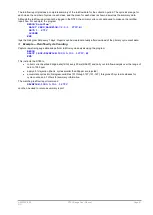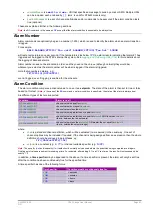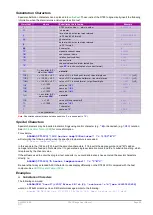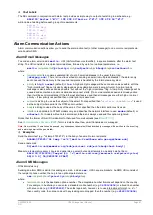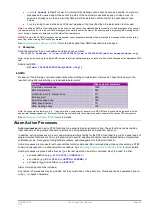
UM-0085-B09
DT80 Range User Manual
Page 94
RG
Part G – Logging and
Retrieving Data
Logging Data
By default, the DT80 returns measurement data to a host computer in real time. However, the DT80 can also
automatically record each reading taken for some or all of a schedule’s channels. These data are stored in the DT80’s
internal memory, and can be retrieved at a later date, using a USB memory device or via one of the communications
ports, or via the web interface (Series 2 only).
Each reading is automatically timestamped.
Logged data is retained in the internal memory until it is explicitly cleared, even if the DT80 is reset or loses power.
Enabling and Disabling Data Logging
LOGON and LOGOFF Commands
By default, data logging is disabled when a schedule is entered. The following commands switch logging on or off. They
may be entered as part of a job, or they may be sent at any time after a job has started running:
Command
Function
LOGON
Enables logging (data and alarms) for all schedules.
LOGOFF
Disables logging (data and alarms) for all schedules.
LOGON
sched
Enables logging for schedule
sched
(data and alarms)
LOGOFF
sched
Disables logging for schedule
sched
(data and alarms)
For example the following job defines a schedule and enables logging:
BEGIN"LUMPY" RA2M 2V 3V LOGONA END
This will create a store file with the default size. Every two minutes, two voltages will be measured and the results will be
stored, along with the time at which the measurements were taken.
Disabling Data Logging for Specific Channels
If logging is enabled for a schedule then by default all channels defined therein will be logged. To disable logging for
specific channels:
•
use the
NL
(no log) channel option, or
•
use the
W
channel option (working channel; do not log, return or display)
How Data and Alarms are Stored
The DT80 File System
The DT80's internal flash memory is organised as a DOS-compatible file system, which uses files and folders in a similar
way to a desktop computer. When a USB memory device is inserted it is treated in a similar way. Note that:
•
the USB memory device, if present, is referred to as drive
A:
•
the DT80's internal file system is referred to as drive
B:
•
the DT80's internal RAM disk (a small but higher speed file system) is referred to as drive
D:
(The
DIR
and
DIRTREE
commands can be used to explore the contents of either drive. For example
DIRTREE B:
will list the names of all files and directories on the internal file system.)
The standard internal file system has a capacity of 2Gbyte. The DT80 stores approximately 90,000 data values per
megabyte of memory, so the internal memory can hold approximately 160,000,000 data values.
The internal RAM disk has a capacity of 128kbyte (approx. 10,000 data values).
Note:
RAM disk (
D:
) may be cleared if all power to the DT80 is lost (including the lithium memory backup battery). It should not
normally be used for long term data storage.


